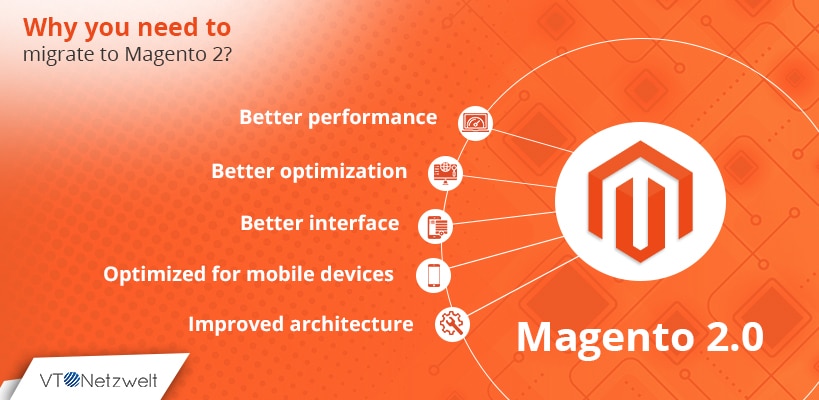Summary of the Article
Have a project in mind?
Schedule a Call5 Legitimate reasons to migrate to Magento 2
Summary of the Article
Magento 2 was released in 2015 as the latest version of the Magento eCommerce platform, which is used in one of four companies worldwide. Sooner or later, you have to migrate your current site from old to the latest Magento 2 version because Magento 1 is no longer the focus of Magento Inc.
As one of the largest providers of professional online shop software, the introduction of Magento 2.0 affects not only small retailers but also a number of large houses. The platform has been patched several times since the launch of Magento 2.0 in April 2017.
In particular, security gaps have been closed, and the support of ling BIN numbers, as requested by Mastercard since the end of June 2017, has been guaranteed.
Magento 1 users who are considering switching to Magento 2 will find this overview helpful. Magento 2 offers useful features to solve problems that many have faced while using Magento 1.
We will explain features, expected costs, and timeframes so that you can more easily decide how to proceed with Magento 1 and when to start the project ( our advice: the sooner, the better).
Why are e-store owners afraid to migrate?
Every potential customer knows the necessity of migrating Magento 1 to Magento 2. Also, they agree with this good idea but don’t migrate. Why?
Well, there are three main reasons why store owners are not rushing right away, and these reasons need to be addressed.
Fear the cost of migration
It is almost impossible to start such an important project with a poor understanding of costs. You can tackle this fear by getting a detailed estimate from the experienced Magento team. VT Netzwelt is a reliable Magento agency that believes in keeping transparency with clients. Thus we provide a free 2-hour assessment for Magento migration. You can plan a smooth transition.
Fear changes
When people get familiar with something, they find it safe. Therefore, merchants fear change, even if it sounds good. Sometimes this pressure is so powerful that it’s hardly impossible to overcome. As an entrepreneur, you need to understand that fear holds you back, but migration will drive you forward.
Merchants want things just to work
When your customers are happy, and your store is already popular and fast, what else would you wish for? Moving with time is very important because sometimes the cost of doing nothing can be higher.
Merchants are not aware of the reasons why they need to migrate. June 2020 is marked as the end of Magento 1, and it’s for real.
The following are given five legitimate reasons for Magento migration
Improved performance
Websites with Magento 2 run on average 20% faster than websites with Magento 1. It has been shown that Magento 2 websites are very powerful, contributes to increased sales, and improve the search engine ranking.
With the new architecture and a full page cache already integrated with the community edition, Magento 2 offers excellent performance. The start, category, and product pages are delivered on average up to 50 percent faster than in shops based on Magento 1.
Optimized purchasing process and checkout
The Magento 1 purchasing process comprises six steps, while Magento 2 processes the purchasing in just two simple steps and has the instant purchase feature.
With Instant Purchase, retailers can now offer to return faster shopping experience by using previously saved payment and delivery information so that the checkout process is bypassed and customers are directed to a confirmation page.
Historical data shows that websites could increase sales with simpler payment methods. Lengthy checkout processes are finally a thing of the past with the significantly streamlined 2-step checkout.
The checkout remains clear for the user, and the automatic validation in forms ensures better user experience and higher conversions. The user sees the products in his shopping cart at any time, including article pictures, individual prices, total price, and shipping costs.
Everything else is hidden during the checkout in order not to endanger the purchase.
Better administration interface and Improved search
This is a dream come true for non-tech-savvy users! The Magento 1 user interface has often been described as confusing for business customers, but Magento 2 offers a clear, user-friendly interface in which even users who are not tech-savvy can find their way around and add new products with ease.
Thanks to Elasticsearch, the well-known standard search function from Magento 1 is significantly improved. The previous development effort for the integration of a search solution like SOLR can be significantly reduced.
Elasticsearch currently speaks 33 languages and is ideal for internationally active shop operators.
Optimized for mobile devices and more personalized
Nowadays, more users than ever do their shopping via smartphone, so it is essential to have websites that are well displayed on mobile phones. Magento 1 websites did not perform optimally on mobile devices, but Magento 2 makes mobile commerce a priority.
With the release of the Progressive Web Application Studio (PWA) in Magento 2.3, users can increase mobile performance even further. Also, Magento 2 supports the personalized control of prices or advertising banners via the backend.
This means that new and existing customers, in particular, can be better linked to the shop and the brand through cross-selling and up-selling campaigns. The segmentation tools are easy to use and can be set up with just a few clicks.
New system architecture with a clearer backend
Magento 2 has been further developed into a modern and flexible enterprise eCommerce framework. The software architecture has an expandable service layer that enables a high degree of customization with a low time-to-market.
The system has a consistently modular structure and has become significantly more flexible for individual adjustments. The backend became much more user-friendly than was the case in Magento 1.
The simplified representation in the material design allows administrators, shop managers, and marketers without a technical background to make changes to products, prices, and Co. very easily.
In addition, the backend is completely responsive, which makes working with mobile devices significantly easier.
In comparison with Magento 1, Magento 2 Admin Panel is much more intuitive and friendly.
In Magento 1, you enjoyed the horizontal menu on the top of the Admin Panel, like this:
But the menu in Magento 2 is vertical on the left and is designed with flat type.
In most reviews of the new interface in Magento 2, the backend interface delivered both improved utilization and being friendly with a larger click and tap button. Clearly, Magento 2 aims directly at merchant targets, who are almost non-technical users.
A simple migration plan looks like this
- Check the extensions and dates on your current website. Decide which extensions are currently part of the Magento 2 core code. Many customers find that they need far fewer adjustments to Magento 2 compared to Magento 1. Also, take the time to remove stale or redundant data from your Magento 1.x database to make migration easier.
- Create a Magento 2 shop and prepare it for migration. In order to be able to access backed up data in case of unexpected difficulties, it is recommended to make a copy of your Magento 1.x database. Use the data from this duplicated Magento 1.x database as the source for your migration.
- Test run: Before you start the migration in the production environment, follow the tried and tested procedure recommendation to simulate all migration steps in a test environment.
It is a recommended practice to suspend all administrative tasks in both Magento 1.x and Magento 2 while the migration test is running (and during the actual data migration).
- Start the migration using the data migration tool. This tool will migrate customers, catalogs, orders, deliveries, and core configuration. However, it is important to know what the tool is not migrating.
Your custom data, administrator privileges, media files, and certain other custom technical aspects are not seamlessly transferred in the tool.
- Migrate the visual design from Magento 1 to Magento 2 and make changes at the user interface level.
- If necessary, make changes to the migrated data.
- Update incremental data. After the data migration, you will have to gradually collect the data updates that have been added to the Magento 1 shop (such as new orders and reviews).
After that, you have to go into delta mode to transfer this data to the Magento 2 shop.
-
- Go online: Now that your Magento 2 website is updated and working properly, you can switch to the new website!
Which Magento 2 version is right for your needs?
Magento 2 Open Source
This is a freely available open-source version of Magento 2 that does not provide technical or account management support and lacks many of the functionalities related to conversion, efficiency, and scalability and that in Magento Commerce 2 are installed. This version is best suited for smaller companies.
Magento Commerce 2
The corporate version of Magento 2 is tailored for medium and large companies and offers a wide range of management, marketing, B2B, and business intelligence options.
Magento Commerce is cloud-based
This has the advantage for retailers that they only need one contract and that they only have to access one support contact for commerce and hosting. In limited cases, it is possible to host Magento Commerce in-house.
Further considerations
Cost
Just like with an upgrade between Magento 1.x versions, the workload for the migration from Magento 1 to Magento 2 depends on how you set up your website and how much your website has been customized.
Furthermore, as mentioned earlier, migration is the right time to consider upgrading your e-commerce website, such as improving user experience (UX). Changes of this kind have a further impact on the cost of migrating to Magento 2.
Extensions and custom code
You may have added third-party extensions to your Magento 1 eCommerce store to provide functionality that is not standard.
When migrating to Magento 2, a careful check must be made to determine if extensions can be removed and replaced with standard Magento 2 features or with a comparable Magento 2 extension available on the market.
The right partner is crucial for success. The migration from Magento 1 to Magento 2 requires a careful approach, regardless of which Magento 2 option you choose.
Are you still confused?
Get a consultation from the expert Magento Certified developers of VT Netzwelt. We can design the eminent solution, review your code, and answer every migration question properly.
Our experts will move your business to Magento 2 from Magento 1 or any other eCommerce platform flawlessly. You can also get assistance for building a brand-new online store.
If you need help to keep up the wealth of your eCommerce store, Contact us now!










